Mechanical and Magnetic Properties of Double Layered Nanostructures of Tin and Zirconium Oxides Grown by Atomic Layer Deposition
Abstract
:1. Introduction
2. Materials and Methods
3. Film Structure and Morphology
4. Mechanical Properties
5. Magnetic Properties
6. Conclusions
Author Contributions
Funding
Institutional Review Board Statement
Informed Consent Statement
Data Availability Statement
Conflicts of Interest
References
- Kobayashi, N.; Masumoto, H.; Takahashi, S.; Maekawa, S. Optically transparent ferromagnetic nanogranular films with tunable transmittance. Sci. Rep. 2016, 6, 34227. [Google Scholar] [CrossRef]
- Sheng, P.; Wang, B.; Li, R. Flexible magnetic thin films and devices. J. Semicond. 2018, 39, 011006. [Google Scholar] [CrossRef]
- Schiavone, G.; Desmulliez, M.P.Y.; Walton, A.J. Integrated magnetic MEMS relays: Status of the technology. Micromachines 2014, 5, 622–653. [Google Scholar] [CrossRef]
- Niarchos, D. Magnetic MEMS: Key issues and some applications. Sens. Actuators 2003, 109, 166–173. [Google Scholar] [CrossRef]
- Foerster, M.; Menéndez, E.; Coy, E.; Quintana, A.; Gómez-Olivella, C.; de los Ojos, D.E.; Vallcorba, O.; Frontera, C.; Aballe, L.; Nogués, J.; et al. Local manipulation of metamagnetism by strain nanopatterning. Mater. Horiz. 2020, 7, 2056–2062. [Google Scholar] [CrossRef]
- Sort, J.; Concustell, A.; Menéndez, E.; Suriñach, S.; Baró, M.D.; Farran, J.; Nogués, J. Selective generation of local ferromagnetism in austenitic stainless steel using nanoindentation. Appl. Phys. Lett. 2006, 89, 032509. [Google Scholar] [CrossRef] [Green Version]
- Zhou, H.; Pei, Y.; Fang, D. Magnetic Field Tunable Small-scale Mechanical Properties of Nickel Single Crystals Measured by Nanoindentation Technique. Sci. Rep. 2014, 4, 4583. [Google Scholar] [CrossRef]
- Papakonstantinou, P.; Lemoine, P.; McLaughlin, J.; MacKay, K.; Dodd, P.M.; Pollard, R.J.; Atkinson, R. Nanoindentation studies of FeXN (X = Ta, Ti) soft magnetic films. J. Appl. Phys. 2000, 87, 6170. [Google Scholar] [CrossRef] [Green Version]
- Baco, S.; Abbas, Q.A.; Hayward, T.J.; Morley, N.A. An investigation on the mechanical properties of soft magnetostrictive FeCoCr films by nanoindentation. J. Alloys Comp. 2021, 881, 160549. [Google Scholar] [CrossRef]
- Lee, J.; Nagarajan, G.S.; Shon, Y.; Kwon, Y.; Kang, T.W.; Kim, D.Y.; Kim, H.; Im, H.; Park, C.-S.; Kim, E.K. Room temperature transparent conducting magnetic oxide (TCMO) properties in heavy ion doped oxide semiconductor. AIP Adv. 2017, 7, 085114. [Google Scholar] [CrossRef] [Green Version]
- Ginley, D.S.; Bright, C. Transparent conducting oxides. MRS Bull. 2000, 25, 15–18. [Google Scholar] [CrossRef]
- Batzill, M.; Diebold, U. The surface and materials science of tin oxide. Prog. Surf. Sci. 2005, 79, 47–154. [Google Scholar] [CrossRef]
- Çetinörgü, E.; Goldsmith, S. Chemical and thermal stability of the characteristics of filtered vacuum arc deposited ZnO, SnO2 and zinc stannate thin films. J. Phys. D Appl. Phys. 2007, 40, 5220–5226. [Google Scholar] [CrossRef]
- Qadri, S.B.; Kim, U.H.; Khan, H.R.; Pique, A.; Horwitz, J.S.; Chrisey, D.; Kim, W.J.; Skelton, E.F. Transparent conducting films of In2O3-ZrO2, SnO2-ZrO2 and ZnO-ZrO2. Thin Solid Films 2000, 377–378, 750–754. [Google Scholar] [CrossRef]
- Jang, J.; Kitsomboonloha, R.; Swisher, S.L.; Park, E.S.; Kang, H.; Subramanian, V. Transparent high-performance thin film transistors from solution-processed SnO2/ZrO2 gel-like precursors. Adv. Mater. 2013, 25, 1042–1047. [Google Scholar] [CrossRef]
- Manjula, N.; Selvan, G. Magnetic and antibacterial properties of Zr-doped SnO2 nanopowders. J. Mater. Sci. Mater. Electron. 2017, 28, 15056–15064. [Google Scholar] [CrossRef]
- Aarik, J.; Aidla, A.; Mändar, H.; Uustare, T.; Sammelselg, V. Growth kinetics and structure formation of ZrO2 thin films in chloride-based atomic layer deposition process. Thin Solid Films 2002, 408, 97–103. [Google Scholar] [CrossRef]
- Alnes, M.E. Transparent Conducting Oxides by Atomic Layer Deposition. Ph.D. Thesis, University of Oslo, Oslo, Norway, 2014. Available online: https://www.duo.uio.no/handle/10852/48768 (accessed on 24 April 2021).
- Arroval, T.; Aarik, L.; Rammula, R.; Kruusla, V.; Aarik, J. Effect of substrate-enhanced and inhibited growth on atomic layer deposition and properties of aluminum–titanium oxide films. Thin Solid Films 2016, 600, 119–125. [Google Scholar] [CrossRef]
- Chen, Z.; Lai, J.K.L.; Shek, C.-H. Facile strategy and mechanism for orthorhombic SnO2 thin films. Appl. Phys. Lett. 2006, 89, 231902. [Google Scholar] [CrossRef]
- Kong, L.; Ma, J.; Zhu, Z.; Luan, C.; Yu, X.; Yu, Q. Synthesis of orthorhombic structure epitaxial tin oxide film. Mater. Lett. 2010, 64, 1350–1353. [Google Scholar] [CrossRef]
- Joy, K.; Lakshmy, S.S.; Thomas, P.V. Band gap tuning in nanocomposite ZrO2-SnO2 thin film achieved through sol–gel co-deposition method. J. Sol Gel Sci. Technol. 2012, 61, 179–184. [Google Scholar] [CrossRef]
- Jõgiaas, T.; Kull, M.; Seemen, H.; Ritslaid, P.; Kukli, K.; Tamm, A. Optical and mechanical properties of nanolaminates of zirconium and hafnium oxides grown by atomic layer deposition. J. Vac. Sci. Technol. A 2020, 38, 022406. [Google Scholar] [CrossRef] [Green Version]
- Piirsoo, H.-M.; Jõgiaas, T.; Mändar, H.; Ritslaid, P.; Kukli, K.; Tamm, A. Microstructure and mechanical properties of atomic layer deposited alumina doped zirconia. AIP Adv. 2021, 11, 055316. [Google Scholar] [CrossRef]
- Menčík, J. Uncertainties and errors in nanoindentation. In Nanoindentation in Materials Science; Nemecek, J., Ed.; InTech Open: Rijeka, Croatia, 2012. [Google Scholar] [CrossRef]
- Pelegri, A.A.; Huang, X. Nanoindentation on soft film/hard substrate and hard film/soft substrate material systems with finite element analysis. Comp. Sci. Technol. 2008, 68, 147–155. [Google Scholar] [CrossRef]
- Jönsson, B.; Hogmark, S. Hardness measurements of thin films. Thin Solid Films 1984, 114, 257–269. [Google Scholar] [CrossRef]
- Burnett, P.J.; Rickerby, D.S. The relationship between hardness and scratch adhesion. Thin Solid Films 1987, 154, 403–416. [Google Scholar] [CrossRef]
- Chicot, D.; Lesage, J. Absolute hardness of films and coatings. Thin Solid Films 1995, 254, 123–130. [Google Scholar] [CrossRef]
- Tuck, J.R.; Korsunsky, A.M.; Davidson, R.I.; Bull, S.J.; Elliott, D.M. Modelling of the hardness of electroplated nickel coatings on copper substrates. Surf. Coat. Technol. 2000, 127, 1–8. [Google Scholar] [CrossRef]
- Puchi-Cabrera, E.S. A new model for the computation of the composite hardness of coated systems. Surf. Coat. Technol. 2002, 160, 177–186. [Google Scholar] [CrossRef]
- Kalam, K.; Seemen, H.; Mikkor, M.; Ritslaid, P.; Stern, R.; Dueñas, S.; Castán, H.; Tamm, A.; Kukli, K. Electric and magnetic properties of atomic layer deposited ZrO2-HfO2 thin films. ECS J. Solid State Sci. Tech. 2018, 7, N117–N122. [Google Scholar] [CrossRef]
- Ning, S.; Zhan, P.; Xie, Q.; Li, Z.; Zhang, Z. Room-temperature ferromagnetism in un-doped ZrO2 thin films. J. Phys. D Appl. Phys. 2013, 46, 445004. [Google Scholar] [CrossRef]
- Rahman, M.A.; Rout, S.; Thomas, J.P.; McGillivray, D.; Leung, K.T. Defect-rich dopant-free ZrO2 nanostructures with superior dilute ferromagnetic semiconductor properties. J. Am. Chem. Soc. 2016, 138, 11896. [Google Scholar] [CrossRef]
- Kalam, K.; Seemen, H.; Ritslaid, P.; Rähn, M.; Tamm, A.; Kukli, K.; Kasikov, A.; Link, J.; Stern, R.; Dueñas, S.; et al. Atomic layer deposition and properties of ZrO2/Fe2O3 thin films. Beilstein J. Nanotechnol. 2018, 9, 119–128. [Google Scholar] [CrossRef] [Green Version]
- Lu, X.; Liang, K.; Gu, S.; Zheng, Y.; Fang, H. Effect of oxygen vacancies on transformation of zirconia at low temperatures. J. Mater. Sci. 1997, 32, 6653–6656. [Google Scholar] [CrossRef]
- Kalita, P.; Saini, S.; Rajput, R.; Jha, S.N.; Bhattacharyya, D.; Ojha, S.; Devesh, K.; Avasthi, D.K.; Bhattacharya, S.; Ghosh, S. Oxygen vacancy mediated cubic phase stabilization at room temperature in pure nano-crystalline zirconia films: A combined experimental and first-principles based investigation. Phys. Chem. Chem. Phys. 2019, 21, 22482–22490. [Google Scholar] [CrossRef]
- Cong, Y.; Li, B.; Yue, S.; Fan, D.; Wang, X. Effect of oxygen vacancy on phase transition and photoluminescence properties of nanocrystalline zirconia synthesized by the one-pot reaction. J. Phys. Chem. C 2009, 113, 13974–13978. [Google Scholar] [CrossRef]
- Bai, X.-M.; Zhang, Y.; Tonks, M.R. Strain effects on oxygen transport in tetragonal zirconium dioxide. Phys. Chem. Chem. Phys. 2013, 15, 19438. [Google Scholar] [CrossRef]
- Lamperti, A.; Lamagna, L.; Congedo, G.; Spiga, S. Cubic/tetragonal phase stabilization in high-k ZrO2 thin films grown using O3-based atomic layer deposition. J. Electrochem. Soc. 2011, 158, G221–G226. [Google Scholar] [CrossRef]
- Chang, G.S.; Forrest, J.; Kurmaev, E.Z.; Morozovska, A.N.; Glinchuk, M.D.; McLeod, J.A.; Moewes, A.; Surkova, T.P.; Hong, N.H. Oxygen-vacancy-induced ferromagnetism in undoped SnO2 thin films. Phys. Rev. B 2012, 85, 165319. [Google Scholar] [CrossRef]
- Dutta, D.; Bahadur, D. Influence of confinement regimes on magnetic property of pristine SnO2 quantum dots. J. Mater. Chem. 2012, 22, 24545–24551. [Google Scholar] [CrossRef]
- Chetri, P.; Choudhury, B.; Choudhury, A. Room temperature ferromagnetism in SnO2 nanoparticles: An experimental and density functional study. J. Mater. Chem. C 2014, 2, 9294–9302. [Google Scholar] [CrossRef]
- Sakthiraj, K.; Hema, M.; Balachandrakumar, K. Room temperature ferromagnetism of tin oxide nanocrystal based on synthesis methods. Physica B 2016, 487, 47–52. [Google Scholar] [CrossRef]
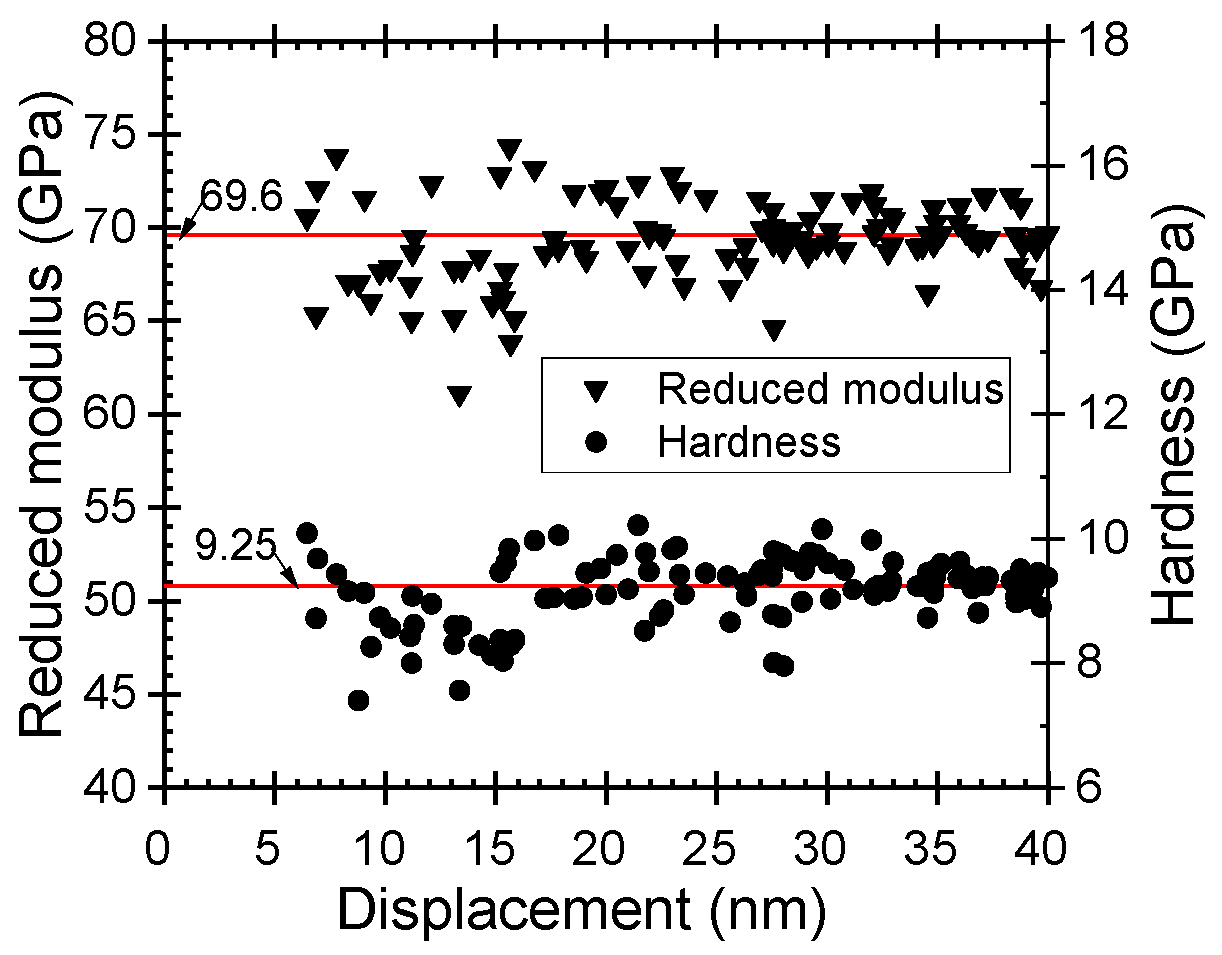
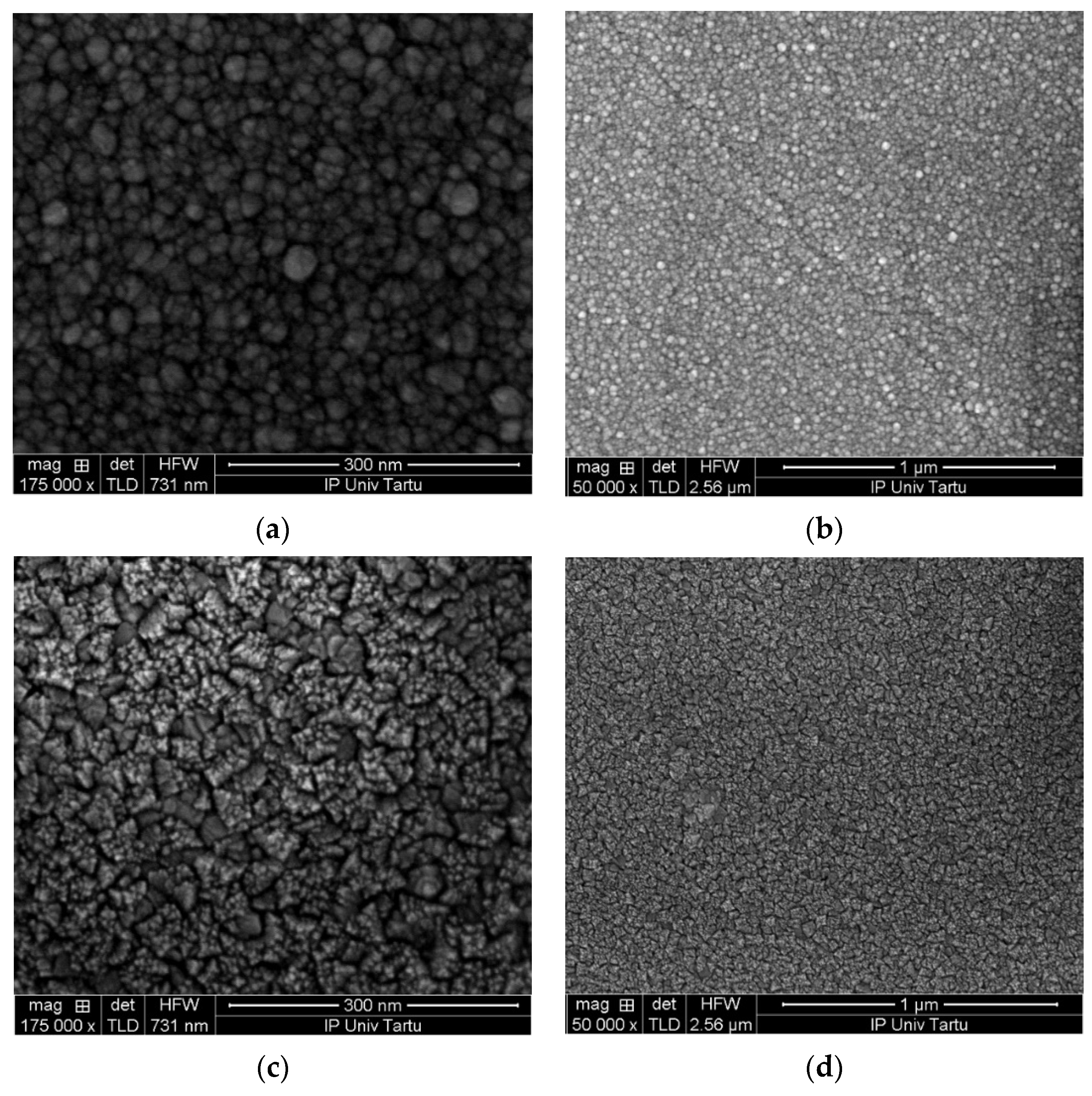
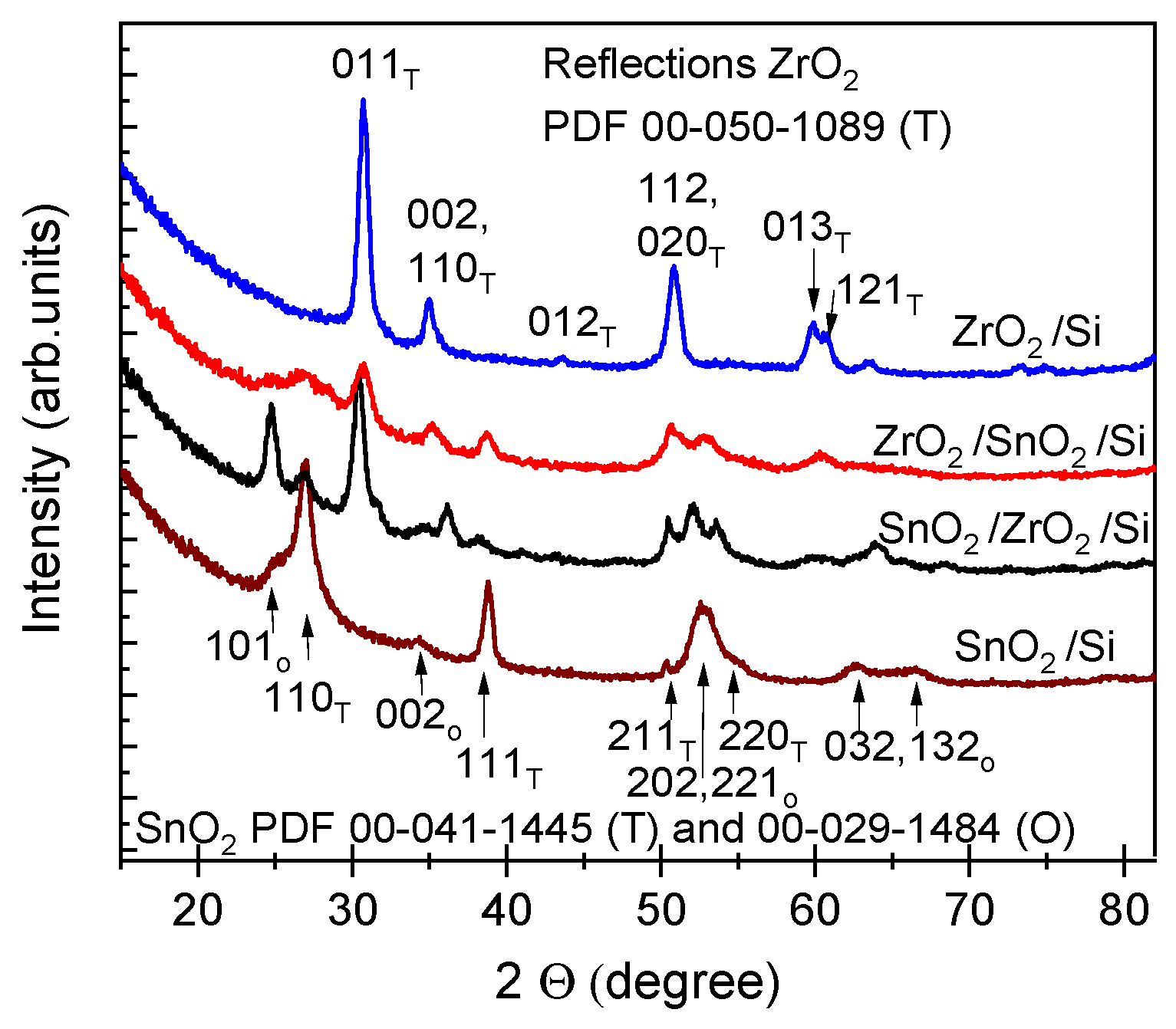
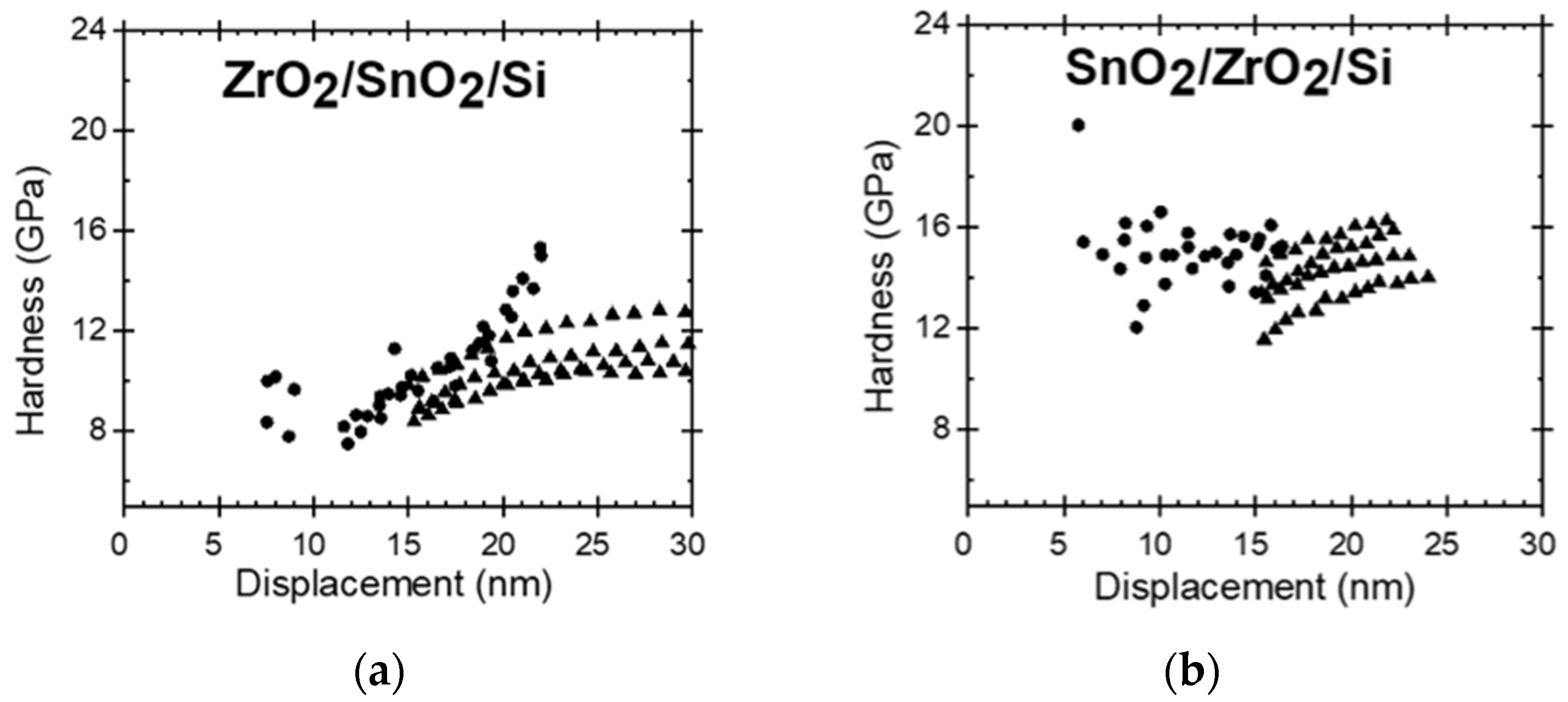
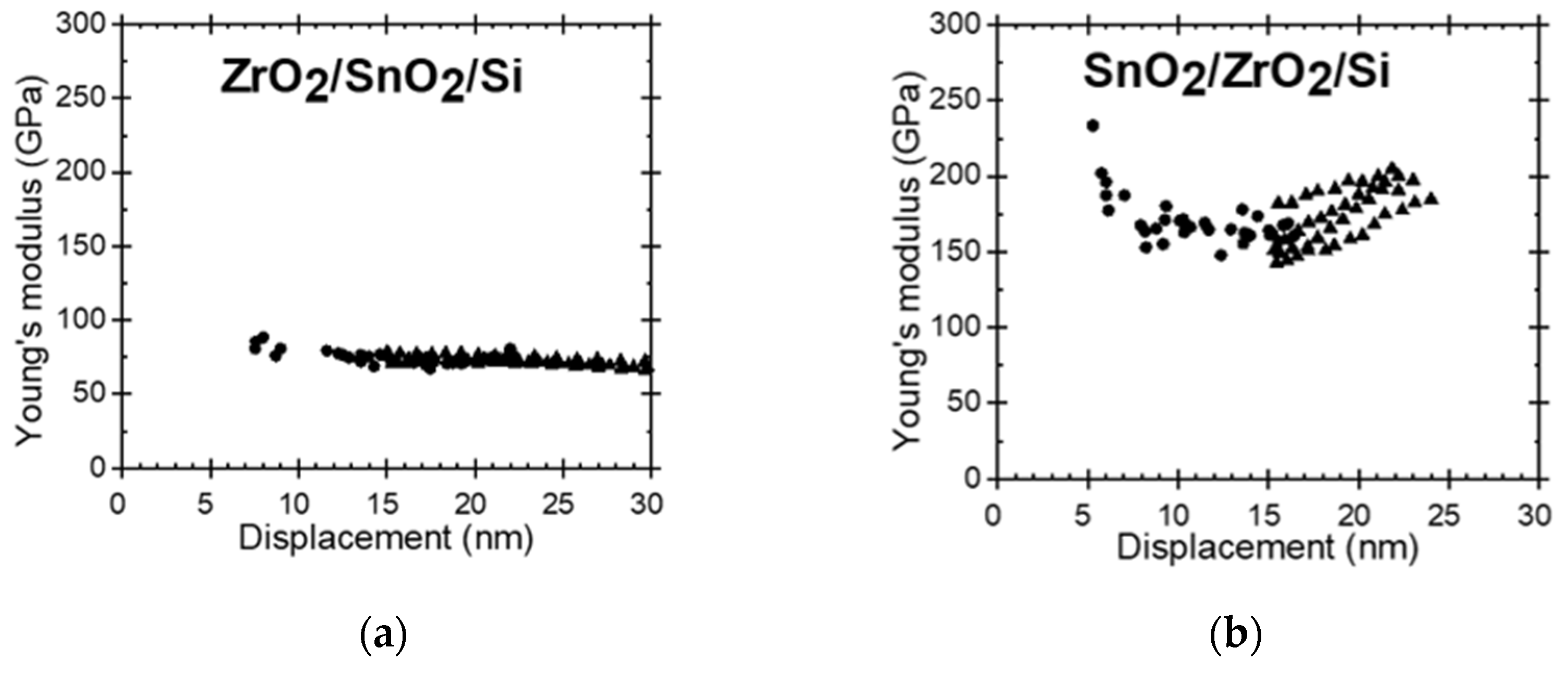
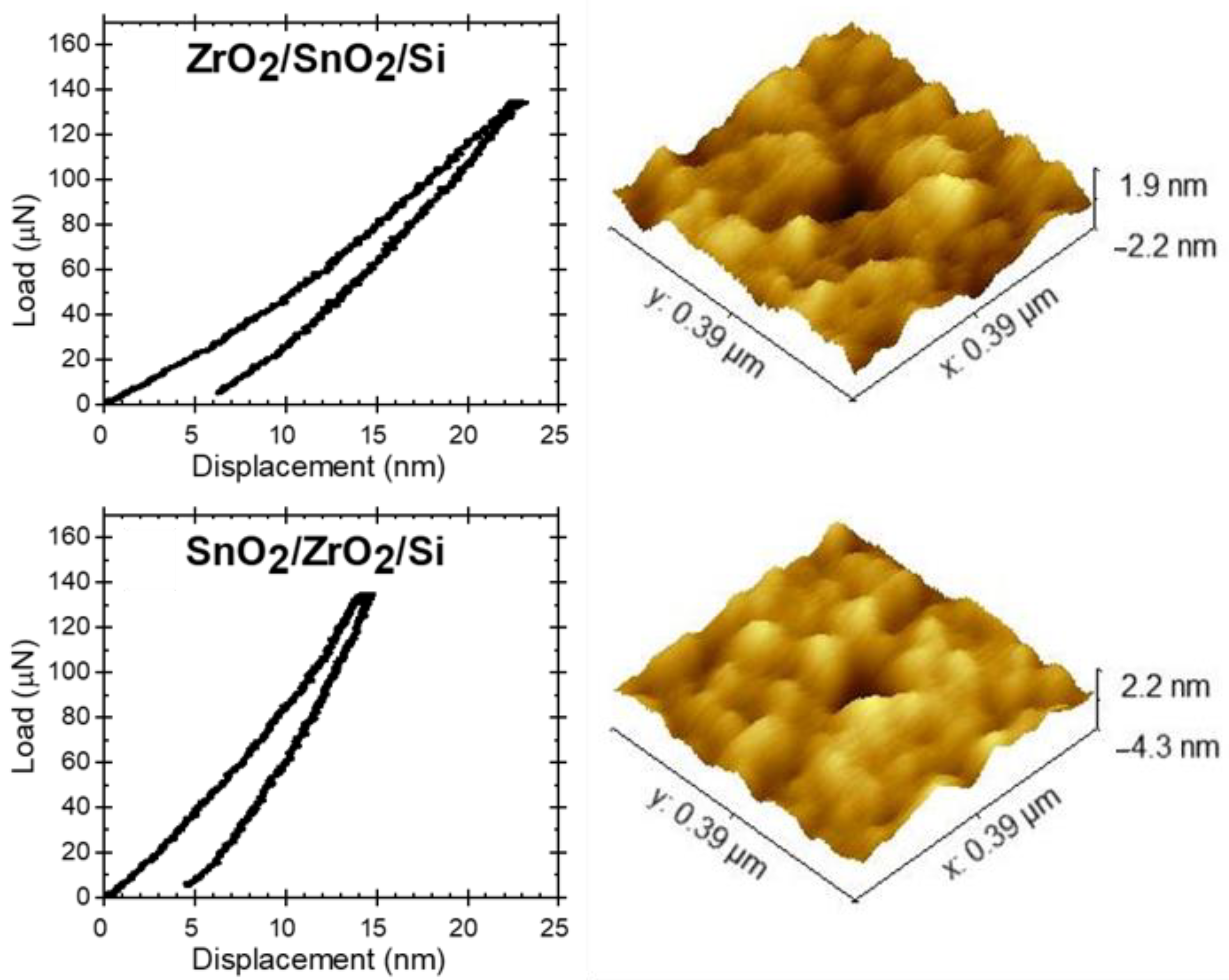
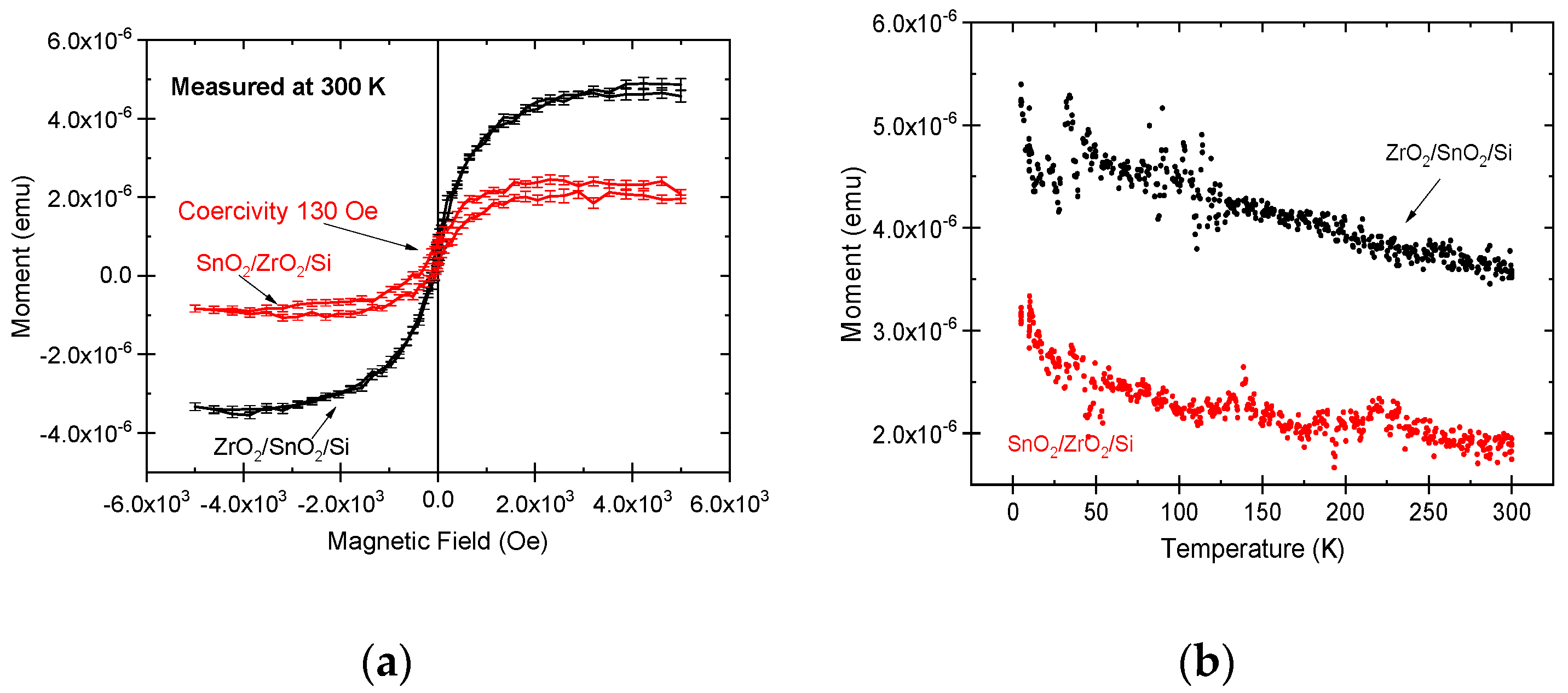
 |  |  | 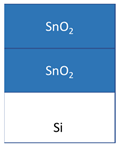 | |
| Description of the Given Layered Nanostructures | SnO2/ZrO2/Si | ZrO2/SnO2/Si | ZrO2/Si | SnO2/Si |
| Thickness, nm | 14.9 (4)/10.4 (3) Total 25.3 nm | 11.4 (2)/10.1 (9) Total 21.5 nm | 21.0 (2) | 24.9 (2) |
| Density, g/cm3 | 7.02/5.82 | 5.68/6.80 | 5.68 | 6.95 |
| Roughness, nm | 1.2 (4) | 1.7 (2) | 2.1 (1) | 1.4 (8) |
| Sample | Hardness (GPa) Geometric Mean ± SD | Hardness (GPa) Range | Young’s Modulus (GPa) Geometric Mean ± SD | Young’s Modulus (GPa) Range |
|---|---|---|---|---|
| ZrO2/Si | 11.5 ± 1.1 | 7.7–13.5 | 96 ± 1 | 84–119 |
| SnO2/Si | 14.8 ± 1.1 | 12.0–18.8 | 175 ± 1 | 142–229 |
| ZrO2/SnO2/Si | 10.8 ± 1.1 | 7.5–15.3 | 72 ± 1 | 62–89 |
| SnO2/ZrO2/Si | 15.1 ± 1.1 | 11.6–20.0 | 171 ± 1 | 143–205 |
| Si | 10.8 ± 1.2 | 7.5–14.0 | 133 ± 1 | 108–167 |
Publisher’s Note: MDPI stays neutral with regard to jurisdictional claims in published maps and institutional affiliations. |
© 2021 by the authors. Licensee MDPI, Basel, Switzerland. This article is an open access article distributed under the terms and conditions of the Creative Commons Attribution (CC BY) license (https://creativecommons.org/licenses/by/4.0/).
Share and Cite
Tamm, A.; Piirsoo, H.-M.; Jõgiaas, T.; Tarre, A.; Link, J.; Stern, R.; Kukli, K. Mechanical and Magnetic Properties of Double Layered Nanostructures of Tin and Zirconium Oxides Grown by Atomic Layer Deposition. Nanomaterials 2021, 11, 1633. https://doi.org/10.3390/nano11071633
Tamm A, Piirsoo H-M, Jõgiaas T, Tarre A, Link J, Stern R, Kukli K. Mechanical and Magnetic Properties of Double Layered Nanostructures of Tin and Zirconium Oxides Grown by Atomic Layer Deposition. Nanomaterials. 2021; 11(7):1633. https://doi.org/10.3390/nano11071633
Chicago/Turabian StyleTamm, Aile, Helle-Mai Piirsoo, Taivo Jõgiaas, Aivar Tarre, Joosep Link, Raivo Stern, and Kaupo Kukli. 2021. "Mechanical and Magnetic Properties of Double Layered Nanostructures of Tin and Zirconium Oxides Grown by Atomic Layer Deposition" Nanomaterials 11, no. 7: 1633. https://doi.org/10.3390/nano11071633
APA StyleTamm, A., Piirsoo, H.-M., Jõgiaas, T., Tarre, A., Link, J., Stern, R., & Kukli, K. (2021). Mechanical and Magnetic Properties of Double Layered Nanostructures of Tin and Zirconium Oxides Grown by Atomic Layer Deposition. Nanomaterials, 11(7), 1633. https://doi.org/10.3390/nano11071633







